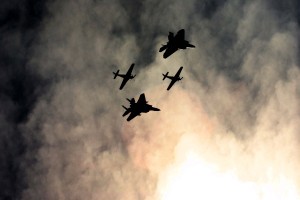 Is it a bird? Is it a plane? It is definitely not Superman. It’s a USA military drone—an unmanned spy plane capable of dropping bombs and firing missiles while its pilot is sitting far enough away to be not affected by the damage being caused. These “top secret” machines have been causing havoc in Afghanistan and Pakistan for years now. Whether it was George W. Bush or Barack Obama who set fire to the killing with these machines, they should be stopped and put to rest.
Is it a bird? Is it a plane? It is definitely not Superman. It’s a USA military drone—an unmanned spy plane capable of dropping bombs and firing missiles while its pilot is sitting far enough away to be not affected by the damage being caused. These “top secret” machines have been causing havoc in Afghanistan and Pakistan for years now. Whether it was George W. Bush or Barack Obama who set fire to the killing with these machines, they should be stopped and put to rest.
According to an article written in 2011 by journalist Nick Turse (co-author of Terminator Planet: The First History of Drone Warfare, 2001-2050), under the administration of President George W. Bush, these drones were primarily devices meant to acquire information or keep tabs on our enemies, specifically in Afghanistan, Pakistan, Iran, and Iraq. In 2008, the end of Bush’s presidency, the Central Intelligence Agency had issued 27 to 36 documented drone strikes. In 2009, the beginning of Obama’s presidency, those numbers increased to a frightening 45 to 53 documented drone strikes. In 2010, there were 11 strikes in the first 18 days of January. The rising numbers are of great concern considering the danger of these drones.
Also, according to Turse, two specific drone prototypes are used today: The MQ-1 Predator, which is seen and used in the famous game collection Call of Duty, and the MQ-9 Reaper, which is understood to be a much larger, deadlier, more accurate drone when compared to its cousin, the MQ-1 Predator.
These deadly drones, according to U.S. Air Force-leaked intel, are held at Kandahar and Jalalabad Air Fields in Afghanistan, while being flown, guided, and controlled thousands of miles away at Wright-Patterson Air Force Base in Dayton, Ohio by “pilots.” In 2011, a $38 million contract was signed with the goal of increasing accuracy with both the MQ-1 Predator and the MQ-9 Reaper. This accuracy increase was helpful in the assassination of one of Osama Bin Laden’s possible successors, Ilyas Kashmiri, in 2011. According to FoxNews.com, this year a drone strike was responsible for the death of Al Queda’s No. 2 man, Abu Yahya Al-Libi. So with these success stories behind them, what exactly is so bad about these plane-like weapons?
The numbers surrounding the use of U.S. Air Force drones are increasingly scary. Turse wrote that in 2004, only five drone combat air patrols (CAPs) flew the skies (each patrol consisting of four drones). By 2009, the number of CAPs was at 38, a 660% increase. Between 2001 and 2008, hours of surveillance (HoS) in the Afghanistan and Iraqi warzones increased 1431%. In 2004 specifically, Reapers (MQ-9s) flew 71 total hours. In 2006, that total jumped to 3,123 hours, while in 2009 HoS jumped to 25,391 hours. Some feel that these numbers are not scary because they are no more than hours of surveillance. But in fact, these hours are more than just simple surveillance.
Flight time corresponds directly with the amount of drones strikes. Turse added that from 2006 to 2009, there were 41 drone strikes, killing 454 militants and civilians. By 2010, there were 667 casualties reported by an Islamabad-based independent research organization. Most of those casualties were reported to be civilian casualties. This is why these drones are dangerous.
In the end, one must consider the safety of civilians when organizing advancement in warfare. I do not believe that the safety of civilians has been considered to its full extent. When we see the number of civilian casualties increase significantly, America should rethink the use of drones for routine military operations that are shown to cause civilian deaths. The objective of warfare is to protect innocent people and accomplish specific goals. If civilian casualties increase, we are failing. America needs to rethink the use of these deadly drones.
